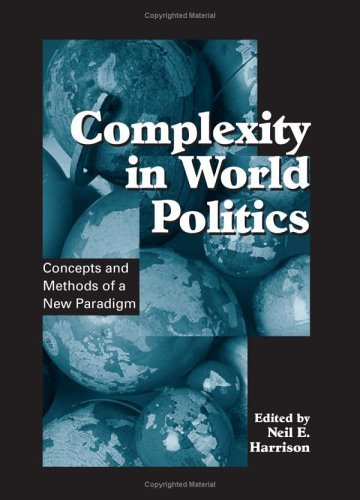Reviewed by
Orion A. Lewis
Department of Political Science, University of Colorado
 This edited volume is a rigorous and accessible attempt to advocate the utility of the "complexity science" paradigm for international relations and apply these insights to substantive issues on the public-policy agenda. The complexity paradigm is characterized by a rejection of mechanistic, overly-simplified models, and instead focuses on "system emergence from complex agent interactions." In constructing this coherent volume, the authors argue for a more realistic set of ontological assumptions, an emphasis on thinking about societies as complex adaptive systems, and greater attention to the process of change - where complex interactions at the micro-level lead to relatively unpredictable outcomes over time at the macro-level.
This edited volume is a rigorous and accessible attempt to advocate the utility of the "complexity science" paradigm for international relations and apply these insights to substantive issues on the public-policy agenda. The complexity paradigm is characterized by a rejection of mechanistic, overly-simplified models, and instead focuses on "system emergence from complex agent interactions." In constructing this coherent volume, the authors argue for a more realistic set of ontological assumptions, an emphasis on thinking about societies as complex adaptive systems, and greater attention to the process of change - where complex interactions at the micro-level lead to relatively unpredictable outcomes over time at the macro-level. The authors argue that many of these aggregate outcomes can be explored by focusing on actors across levels of analysis. By positing agents' preferences, relationships, and feedback mechanisms, agent based models (ABM) can explore the various paths down which systems may evolve. In other words, more realistic micro-foundations lead researchers to theorize and model social outcomes, without falling into excessive reductionism. The editor, Neil E. Harrison, contends that the use of this scientific lens allows researchers to view global politics in novel ways and develop better policy prescriptions.
The book can be roughly divided into three main parts: the first part highlights the differences between the complexity paradigm and status quo positivist frameworks of structuralism and rational choice. The second section utilizes these theoretical concepts and applies them to empirical puzzles regarding ethnic conflict and the origins and evolution of international regimes. Finally, the last third of the volume debates the epistemological foundations of complexity theory and the preferred methodology of ABM.
The authors highlight important conceptual differences that allow complexity theory to better explain some aspects of social systems, such as the importance of agency, the uncertainty of complex systems, and the process of change. However, as David C. Earnest and James N. Rosenau argue in their critique in the third section of the book, complexity models are neither inductive nor deductive and therefore do not present a comprehensive theory of politics. Indeed, the authors fail to present a comprehensive theory that links all of the conceptual tools that they utilize or clarify the conditions under which it is appropriate to use one concept over another. It seems that the over-arching theoretical link missing from the analysis is evolutionary theory. For example, the authors utilize such concepts as emergence, randomness, co-evolution, fitness/selection and sociobiology, all of which are derived from scientific frameworks in evolutionary biology. Yet the precise differences between "complexity science" and a science based on evolutionary biology remain unclear. Given the significant overlap, it is important for researchers to know whether this is simply a difference in terminology, or whether there are substantive differences that would cause one framework to be used over another?
Perhaps part of the problem relates to another of Earnest and Rosenau's critiques - that an emphasis on autonomous agents fails to capture a key aspect of human societies: the existence of authority. Conceptually authority and agent autonomy seem to be mutually exclusive, yet reality tells us that both structure and agency matter. Thus the burden for complexity theorists is to account for the differences in authority structures and the degree to which they constrain action. Can complexity science account for the relative strength of political institutions, or does it always view organization and authority as simply superstructure built on the micro-foundations of agent interaction, and therefore exceptionally malleable?
Methodologically, the volume presents a well-reasoned argument for the value of simulation, the strength of which is controlled manipulation - allowing researchers to experiment and explore possible outcomes. While the authors thoroughly debate the validity of simulation, not one of the chapters empirically demonstrate how ABMs add insight to any of the substantive issues. Additionally, the authors do not explicitly address other methods that might be used to analyze complexity, such as process tracing or analytical narratives.
Some critiques stem solely from the fact that the work is presented as part of a battle of the paradigms, which inevitably creates opposition. I argue it might be more helpful to think of complexity not as a "paradigm" but simply another "approach" in a methodologically pluralistic field. Additionally, terminology such as "meta-agents" and "internal rule models", while more conceptually accurate, needlessly complicate the picture and makes the work less accessible to a broader international relations audience. Such semantic differences not only underscore the fundamental differences in paradigms, but also make it more difficult to bridge the divide between status quo and alternative approaches without a wholesale rejection of the other. Overall this is an interesting, conceptually rich, clearly delimited and innovative body of work, yet it also sparks a number of important "philosophy of science" questions that should determine the future direction of this type of inquiry.
Return to Contents
of this issue
© Copyright Journal of Artificial Societies and Social Simulation, 2007